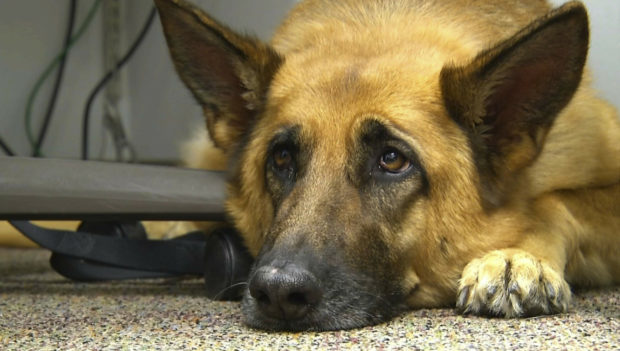Scientists take a peek behind those sad puppy dog eyes
NEW YORK – What’s behind those hard-to-resist puppy dog eyes?
New research suggests that over thousands of years of dog domestication, people preferred pups that could pull off that appealing, sad look. And that encouraged the development of the facial muscle that creates it.
Today, pooches use the muscle to raise their eyebrows and make the babylike expression. That muscle is virtually absent in their ancestors, the wolves.

FILE – This Feb. 18, 2014 shows Lexy, a therapy dog at Fort Bragg, N.C. A study released on Monday, June 17, 2019 suggests that over thousands of years of dog domestication, people preferred dogs that could pull off the ”puppy dog” eyes look. And that encouraged the evolution of the facial muscle behind it, researchers propose. (AP Photo/Alex Sanz, File)
“You don’t typically see such muscle differences in species that are that closely related,” said Anne Burrows of Duquesne University in Pittsburgh, an author of the study released Monday by the Proceedings of the National Academy of Sciences.
Dogs differ from wolves in many ways, from having shorter snouts, smaller sizes and more expressive faces.
And unlike wolves, dogs heavily rely on human eye contact, whether to know when someone’s talking to them or when they can’t solve a problem, like hopping a fence or getting out the door.
Burrows and her colleagues examined the eye muscles in the cadavers of six dogs and two wolves.
They found dogs have a meaty eye muscle to lift their eyebrows and make puppy dog eyes. But in wolves, the same muscle was stringy or missing.
The scientists also recorded 27 dogs and nine wolves as each stared at a person. Pet pooches frequently and intensely pulled back their eyebrows to make sad expressions, while the wolves rarely made these faces, and never with great intensity.
The researchers believe dogs, over their relatively short 33,000 years of domestication, used this eye muscle to communicate, possibly goading people to feed or care for them — or at least take them out to play. And people, perhaps unwittingly, obliged.
Dog experts not involved with the study were impressed.
“The implications are quite profound,” said Brian Hare from Duke University and who edited the article. Hare wrote in an email that these muscles almost certainly developed because they gave dogs an advantage when interacting with people, and people have been unaware of it.
“The proof has been in their puppy dog eyes all this time!” he said.
Evan MacLean at the University of Arizona called the findings fascinating, but cautioned that the muscle difference could be an indirect effect of other changes rather than a specific response to human influence.
Clive Wynne of the Canine Science Collaboratory at Arizona State University said: “Kudos to the researchers for thinking of a cool way to investigate an important aspect of dogs’ success” with humans.
But he noted in an email that the study has a few snags, particularly the small sampling — only five dog breeds were examined and videos were mainly of Staffordshire bull terriers — and the lack of background information about each animal.
“Did these wolves regularly meet people bearing gifts that might be worth asking for with an endearing face?” he asked.
Burrows said she planned follow-up studies to examine more breeds. /gsg